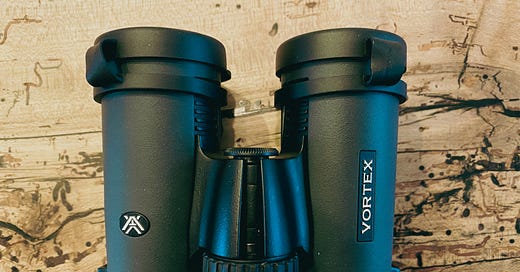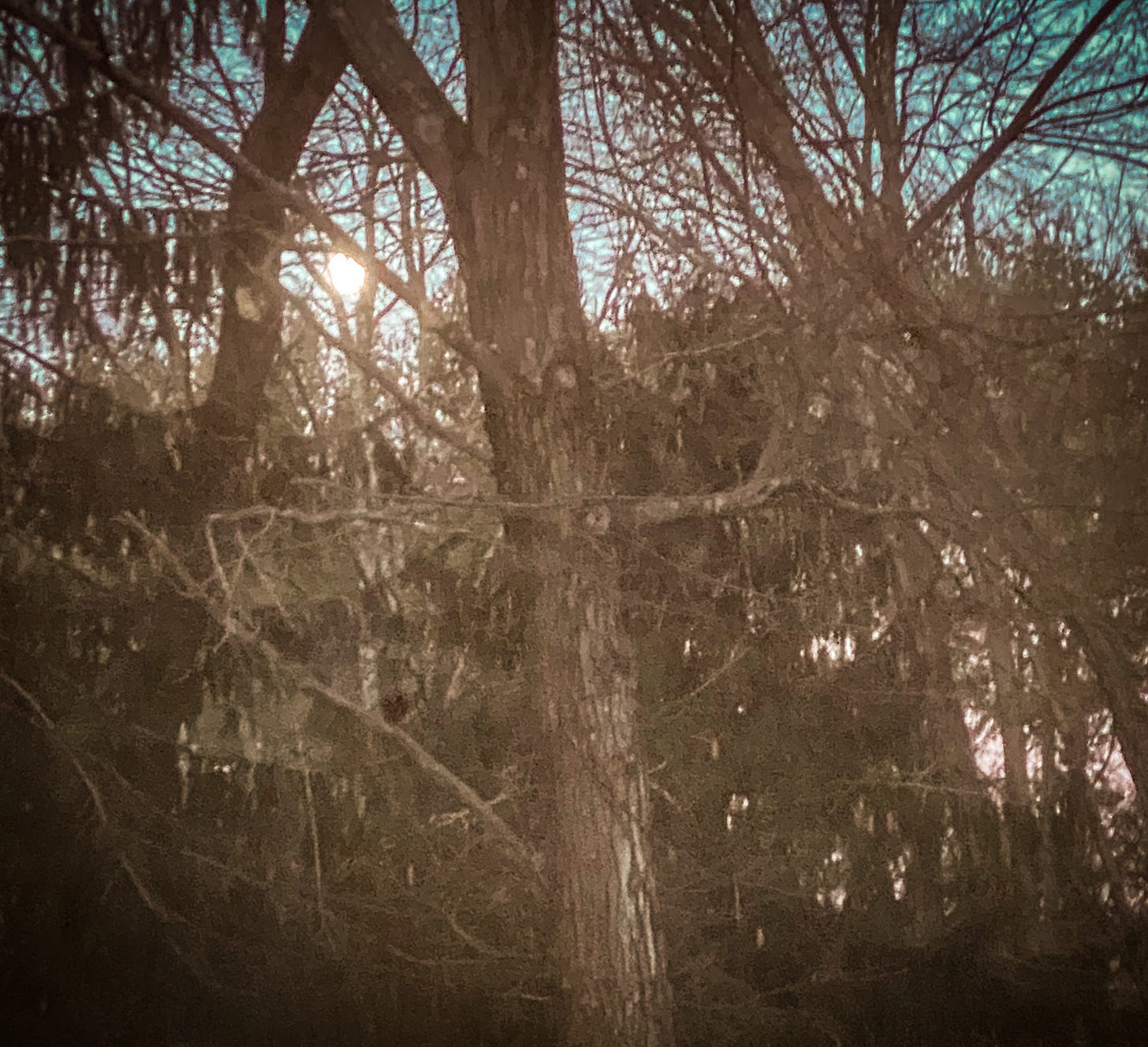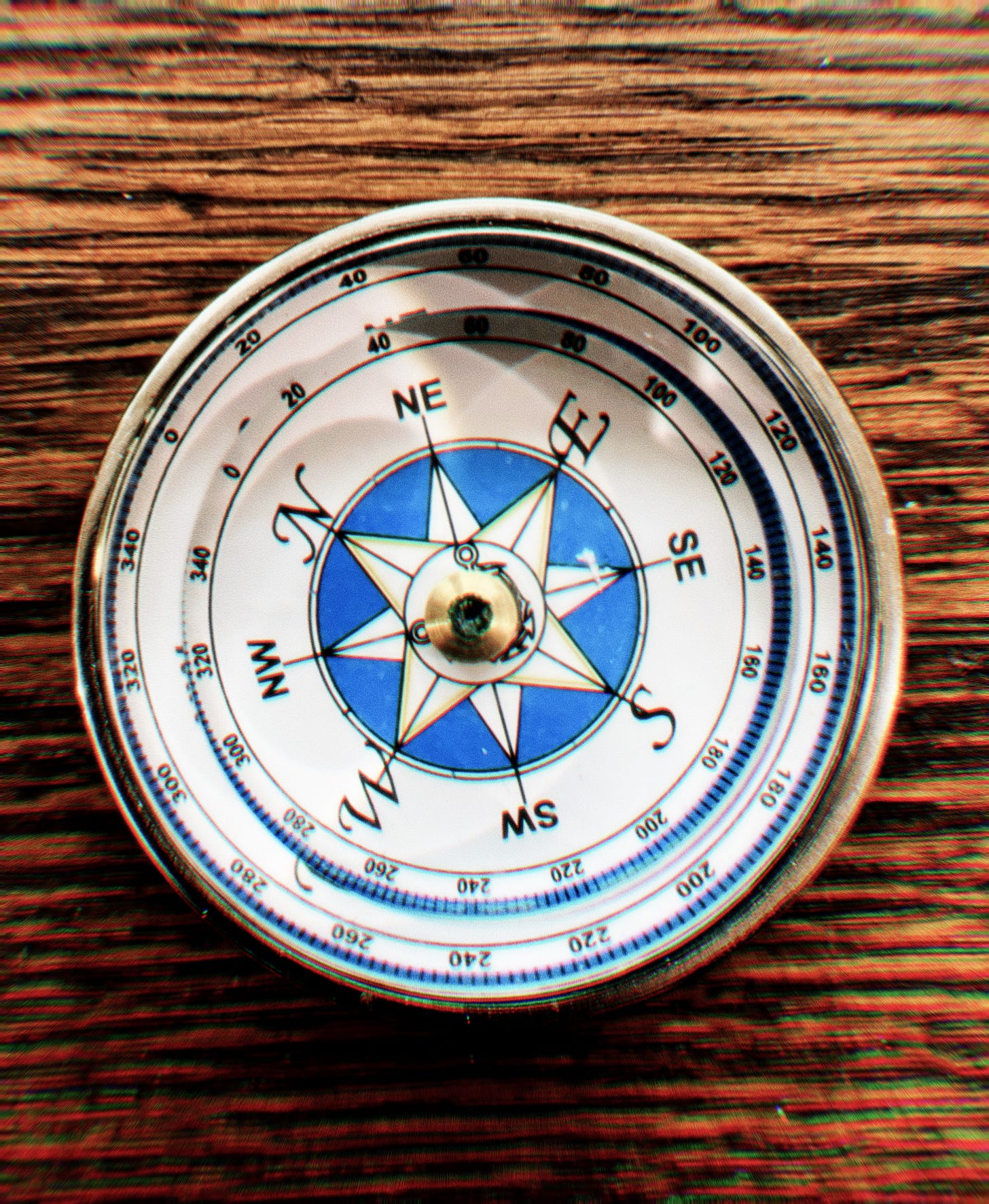On Christmas, my wife gave me a gift of high-powered birding binoculars.
I’ve written about this here — how, at a certain age, some/many of us find ourselves suddenly compelled by birding, even if we’ve never done it before; we have a desire to look at what is outside ourselves, at creatures that have a freedom that we do not, at that which is a harbinger of seasonal change, of climate health, of promise and hope. On my own property during Covid, I watched, in close proximity to my home: Barred owls, Horned owls, Brown eagles, Hawks, Bluebirds, Carolina wrens, Rose-breasted grosbeaks, Pileated woodpeckers, Hummingbirds. My elderly mother was living here with us at the time, and so the act of bird watching provided respite from her frequent attacks; it offered context amidst her chronic blaming and demands that I be something other than who I am (short, chubby, married to a woman, a moderately successful author, etc). Covid isolation resulted in a lot of things, among them a reduction in chemical spraying and the subsequent return of bees and birds in droves, and I watched them closely through the scuffed lenses of a pair of ancient binoculars that had belonged to my late father-in-law. I couldn’t see clearly, but I could see nonetheless, and my takeaway was simple: birds can’t be anything but birds, no matter how hard we might want them to be something else. A Carolina wren cannot be a parrot; a horned owl cannot be a hummingbird, a brown eagle cannot be a chipmunk. If they could not be anything other than what they are, then neither could I.
A Carolina wren cannot be a parrot; a horned owl cannot be a hummingbird. If they could not be anything other than what they are, then neither could I.
Shortly after my mother returned home from her four-month stay in July 2020, I received a call from Adult Protective Services; an investigation had been opened on me at my mother’s behest because, as the keeper of her financial keys and charged with her safety, I refused to allow her to binge-buy thirty-one tubes of Clinique lipstick at $30 each.
Who do you think you are? my mother screamed at me.
Frothing with rage, she managed to convince the City of New York that in not allowing her to engage in the shopping addiction that has frequently resulted in my having to rescue her despite my own meager shekels, I was not fulfilling her vital needs. Unable to speak or respond — this is residual: I suffered from stress-related stuttering as a child —- I silently asked myself the same question that she had. Who do I think I am? When she called me every name in the book — something she’s done for at least fifty years, and something I’ve grown accustomed to, as though she’s asking me to pass the salt over dinner —- it was hard to elucidate the answer to her question: Who do you think you are?
After I had Covid in August 2020 and a Covid-related stroke a few weeks later, my sense of authenticity grew shaky. Authenticity is tied to meaning, self-knowledge, vulnerability, and self-assurance. And so, with an exhausted, injured brain, I began to lose a grip on not only who I was and had been, but why I was. I have spent so much of my life being told what and who to be, that I never knew who I actually was without that external steering. When my mother went home and, a few months later, I began to very slowly heal from the Covid stroke, part of the process involved examining my own authenticity and asking myself the same question my mother had. Who do you think you are? Who was I? Why was I? What was I beyond a wife, a friend, a daughter, an author, a teacher, a cook? I suspect that after living for a year surrounded by death — we have yet to face this fact in this country; we are ill-equipped for it because Americans stink at grief — many of us have come away asking ourselves the same question: Who do we think we are?
One thing I lost — and I am not sure whether this is something that happens when the brain gets injured — was my connection to what had been a vital spiritual life; it was snipped like a hot wire.
So two years out, I asked for binoculars to be able to see more clearly: to see the world and my place in it. To see who I am and who I am not. To see what I still might be, and what I will never be. To see my own possibilities, and my own truth. One thing I lost — and I am not sure whether this is something that happens when the brain gets injured — was my connection to what had been a vital spiritual life; it was snipped like a hot wire. Now I ask myself: What does trauma, both physical and emotional, do to a spiritual sensibility? Is it possible to reclaim it, to rebuild it?
At the beginning of every new year, we, as a culture, aim to better ourselves. Whole swaths of the publishing and diet industries are built around this fact, and there is inherently nothing wrong with it. We strive to better our diets, our bodies, our relationships, our souls, our sex lives. But we do this as if change and habit can be altered by the blithe flipping of the calendar from one month to the next, which is why, by mid-January, most changes don’t stick. It takes far more than a quick decision borne of middle-of-the-night Instagram scrolling for a change to take hold. My wife calls it grooving a new habit.
How do we see the world when we look through high-powered binoculars?
A few years ago, I went into the guest room on the morning of January 1st, sat on my meditation cushion for twenty minutes, and repeated this every day for almost six months. I was grooving a new habit. After six months, I got bored, I got distracted; I stopped. An acquaintance from Austin who was doing the same thing — we weren’t planning on it; she just started sitting too —- also stopped the same time I did, but she kept posting on her social media feeds that meditation had become her practice, her habit, even though —- speaking honestly —- it wasn’t any longer. Many years ago, long before I moved to Connecticut, I was a vegetarian; it was something that my ex wanted to do, and so I joined her, even though I craved a porterhouse steak pretty much every night. For two years straight, we ate tofu dogs and soy isolate chick’n salads, until I did the laundry one day and discovered a mustard-stained napkin from Gray’s Papaya in the pocket of her jeans. There was more perceived social value in her saying she was one thing over another. But: who was she—honestly and authentically, and why did she think that there was something wrong with that? Who did she think she was?
At what point are we at our most authentic, and disconnected from craving and want and compulsion, from the perfectionism of social media, and what and who our worlds demand we be for the sake of popularity, acceptance, posterity, and social value? When we open our email every morning during the month of January and are faced with the concept of New Year/New You, before we fork over the money to join the masses doing daily weigh-ins or detoxes or cleanses, we have to ask ourselves: who are we, authentically.
How do we see the world when we look through high-powered binoculars? Who does it see when it looks back?
* W.S. Merwin








This is so brilliant and so true. Who are we right now? Not who we planned or hoped to be, or like to say we are, but actually are. Why do we not feel comfortable revealing our reality? I love how you relate this to careful observation of birds. Wonderful.
“...and discovered a mustard-stained napkin from Gray’s Papaya in the pocket of her jeans.”
Just laughed out loud as I had forgotten that story! So glad you and Susan found each other.
I always find my birthday coming as it does at the end of the year, bleeds into the new year planning push. Or, at least, end of year/new year reflecting. This year especially so for a couple of reasons.
Particularly for those of us whose families seemed like pieces from a different puzzle, friends save us (sometimes literally) and comfort us, and help us become better versions of ourselves. I’m grateful for your writing, but also for your friendship. Can’t wait to check out your snazzy new binoculars!